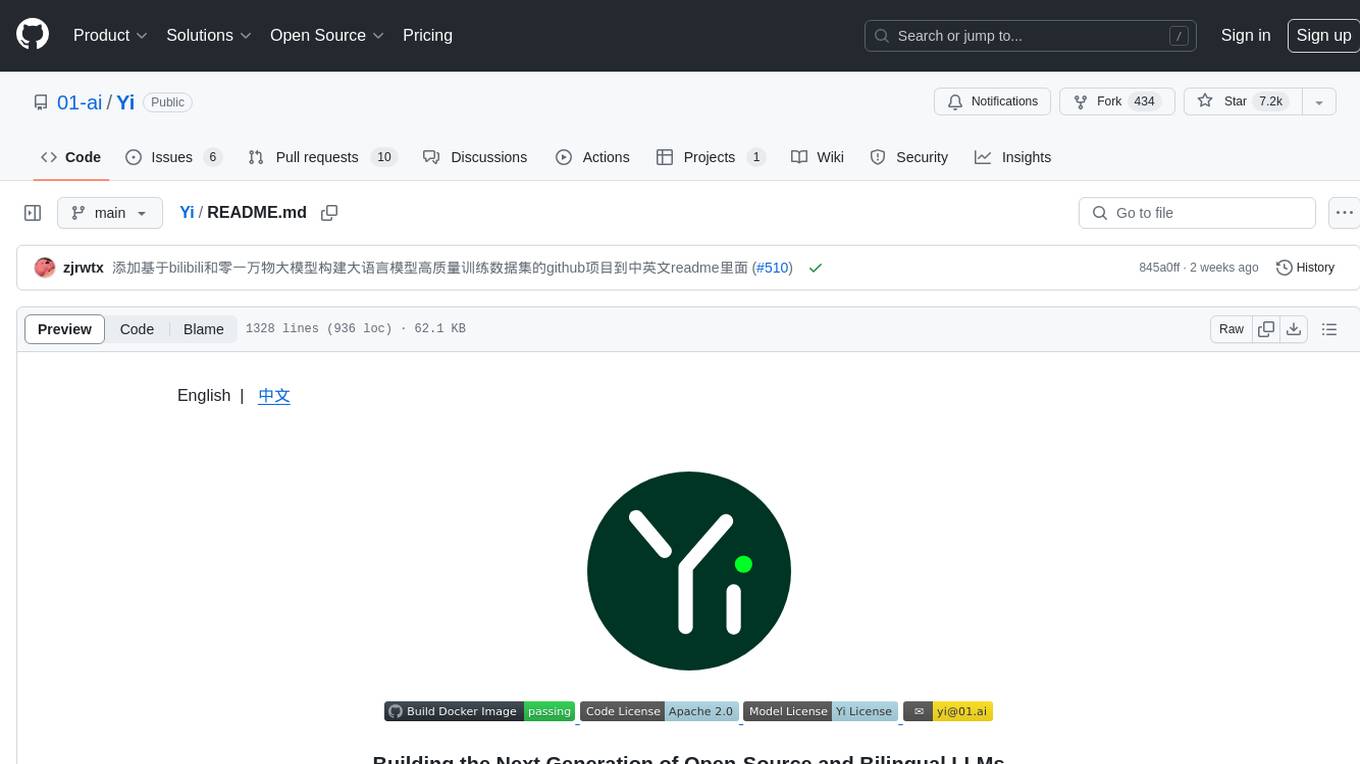
rwkv-qualcomm
Inference RWKV v5, v6 and (WIP) v7 with Qualcomm AI Engine Direct SDK
Stars: 53
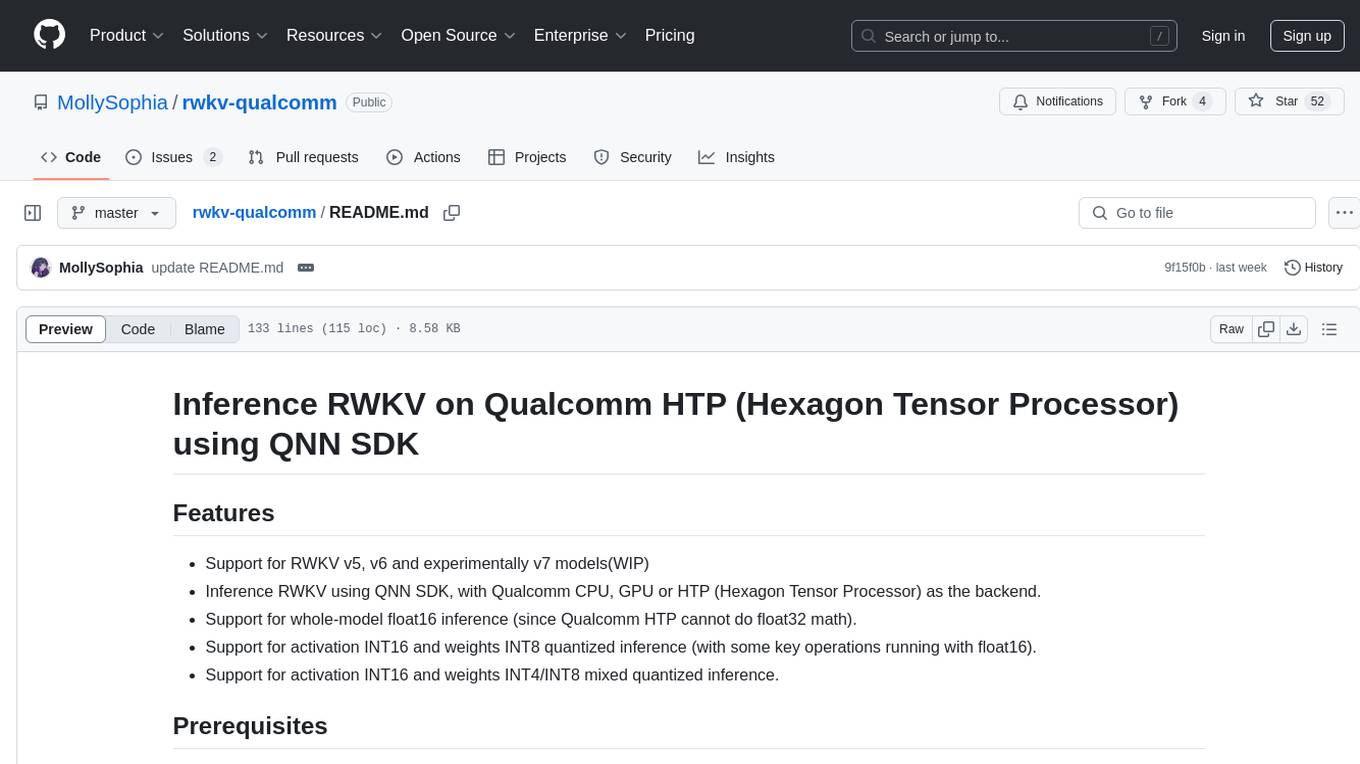
This repository provides support for inference RWKV models on Qualcomm HTP (Hexagon Tensor Processor) using QNN SDK. It supports RWKV v5, v6, and experimentally v7 models, inference using Qualcomm CPU, GPU, or HTP as the backend, whole-model float16 inference, activation INT16 and weights INT8 quantized inference, and activation INT16 and weights INT4/INT8 mixed quantized inference. Users can convert model weights to QNN model library files, generate HTP context cache, and run inference on Qualcomm Snapdragon SM8650 with HTP v75. The project requires QNN SDK, AIMET toolkit, and specific hardware for verification.
README:
- Support for RWKV v5, v6 and experimentally v7 models
- Inference RWKV using QNN SDK, with Qualcomm CPU, GPU or HTP (Hexagon Tensor Processor) as the backend.
- Support for whole-model float16 inference (since Qualcomm HTP cannot do float32 math).
- Support for activation INT16 and weights INT8 quantized inference (with some key operations running with float16).
- Support for activation INT16 and weights INT4/INT8 mixed quantized inference.
- Download and install the QNN SDK from the Qualcomm Developer Network.
- Setup the QNN SDK environment by following the instructions in Qualcomm's documents.
- Setup the $QNN_SDK_ROOT environment variable to point to the QNN SDK installation directory. It should by default be installed at /opt/qcom/aistack/qnn/{version}.
- (Optional) Install the AIMET toolkit for aimet quantization methods: https://quic.github.io/aimet-pages/releases/latest/install/index.html#quick-install
- This project has been verified with:
- QNN SDK 2.31.0
- python==3.10 (as is recommended by QNN SDK documentation)
- onnx==1.17.0
- protobuf==5.29.3
- torch==2.1.2
- aimet-torch==2.0.0
- Hardware: Qualcomm Snapdragon SM8650 with HTP v75 (Xiaomi Mi 14)
python compute_quant_encodings_experimental.py ../models/RWKV-x070-World-1.5B-v3-20250127-ctx4096.pth --output_folder v7_1b5_quant- The quantization encodings file will be in
v7_1b5_quant/RWKV-x070-World-1.5B-v3-20250127-ctx4096.encodingsandv7_1b5_quant/RWKV-x070-World-1.5B-v3-20250127-ctx4096_prefill.encodings - Convert the model file:
python convert_model.py --chunks 1 --qnn_float_width 16 --wkv_customop --quant_encodings v7_1b5_quant/RWKV-x070-World-1.5B-v3-20250127-ctx4096.encodings ../models/RWKV-x070-World-1.5B-v3-20250127-ctx4096.pth(Note: please remove--qnn_float_width 16for devices other than 8Gen3(SM8650)) - Convert the model file (prefill model with sequence length=128):
python convert_model.py --chunks 1 --qnn_float_width 16 --wkv_customop --prefill_model --quant_encodings v7_1b5_quant/RWKV-x070-World-1.5B-v3-20250127-ctx4096_prefill.encodings ../models/RWKV-x070-World-1.5B-v3-20250127-ctx4096.pth(Note: please remove--qnn_float_width 16for devices older than 8Gen3(SM8650)) - The act_bitwidth and weights_bitwidth default to 16 and 8 respectively.
TODO
-
make_context_cache_binary.py: usage: usage: make_context_cache_binary.py [-h] [--use_optrace] [--wkv_customop] [--output_name OUTPUT_NAME] [--prefill] model_lib output_path {SM8650,SM8550,SC8380,SM8475} - Example:
$ python make_context_cache_binary.py --prefill --wkv_customop lib/x86_64-linux-clang/libRWKV-x070-World-1.5B-v3-20250127-ctx4096.so output/ SM8650
- The script will automatically process each of the chunks together.
- The output would be in
output/RWKV-x070-World-1.5B-v3-20250127-ctx4096_combined.binwhich has weight sharing enabled for prefill and decoding graphs.
- Build the demo code:
make -C librwkv-qualcomm - Push the binary and the HTP context cache to the device:
adb push librwkv-qualcomm/obj/local/arm64-v8a/rwkv-qualcomm-demo /data/local/tmp/ && adb push output/RWKV-x070-World-1.5B-v3-20250127-ctx4096_combined.bin /data/local/tmp/ - Push the tokenizer model to the device:
adb push assets/b_rwkv_vocab_v20230424.txt /data/local/tmp/ - Push these QNN libs to the device
/data/local/tmp/(Please change the HTP V75 version to the one you have):
/opt/qcom/aistack/qairt/2.31.0.250130/lib/aarch64-android/libQnnHtpNetRunExtensions.so
/opt/qcom/aistack/qairt/2.31.0.250130/lib/aarch64-android/libQnnHtpNetRunExtensions.so
/opt/qcom/aistack/qairt/2.31.0.250130/lib/aarch64-android/libQnnSystem.so
/opt/qcom/aistack/qairt/2.31.0.250130/lib/aarch64-android/libQnnHtpV75Stub.so
/opt/qcom/aistack/qairt/2.31.0.250130/lib/hexagon-v75/unsigned/libQnnHtpV75Skel.so
- Finally run the demo code:
adb shell
$ cd /data/local/tmp
$ export LD_LIBRARY_PATH=$LD_LIBRARY_PATH:/data/local/tmp
$ # Specify the path to the first model chunk. The second chunk will be loaded automatically.
$ ./rwkv-qualcomm-demo brwkv_vocab_v20230424.txt RWKV-x070-World-1.5B-v3-20250127-ctx4096_combined.bin
- TODO
RWKV v6 1B6 A16W4
130|houji:/data/local/tmp/rwkv $ ./rwkv-qualcomm-demo b_rwkv_vocab_v20230424.txt RWKV-x060-World-1B6-v2.1-20240328-ctx4096_chunk1of2.bin
Loading model context binary from RWKV-x060-World-1B6-v2.1-20240328-ctx4096_chunk1of2.bin
Reading chunk: RWKV-x060-World-1B6-v2.1-20240328-ctx4096_chunk1of2.bin
Buffer size: 719802320
Reading chunk: RWKV-x060-World-1B6-v2.1-20240328-ctx4096_chunk2of2.bin
Buffer size: 586727640
User: 请为我写一首诗。
Assistant: 当然,请告诉我你喜欢什么类型的诗歌。
User: 请写一首描写秋天景色的诗。
Assistant: 秋意渐浓,寒意渐深,
大地已是金黄如火,
落英纷飞,树影绰约,
人心也随之变得清静。
夜空中的繁星在闪闪,
思念似要被所有握住,
但又像是永不消散的孤注,
在这个秋天里如此特别。
请问这首诗符合您需求吗?
Average time per token: 0.0235644s
Average tokens per second: 42.4368
Running on the Qualcomm Snapdragon SM8650 with HTP v75 (Xiaomi Mi 14)
| Model | Precision | Generation Tokens per second | LAMBADA ppl, acc |
|---|---|---|---|
| RWKV v6 1.6B | att-a16w8 + ffn-a16w4 | 42.4368 | 5.09183,65.4182% |
| RWKV v6 1.6B | a16w8 | 31.6564 | 4.75009,66.3497% |
| RWKV v6 1.6B | fp16 | 15.0434 | 4.63598,67.2618% |
| RWKV v6 3B | att-a16w8 + ffn-a16w4 | 21.3172 | 4.46606,68.8725% |
| RWKV v6 3B | a16w8 | 16.2146 | 3.9039,71.3647% |
(Currently QNN's INT4 quantization is the naive linear per-channel quantization, together with the INT16 activation quantization, the perplexity gets a bit worse than the INT8 models. LAMBADA test accuracy seems lower but still acceptable.)
(Experimental) Running with custom WKV kernel
| Model | Precision | Generation Tokens per second | LAMBADA ppl, acc |
|---|---|---|---|
| RWKV v6 1.6B | att-a16w8 + ffn-a16w4 | 47.6698 | 5.09183,65.4182% |
| RWKV v6 7B | a16w4 | 12.9782 | TODO |
- [x] Add demo code for running inference on the device.
- [x] Add support for A16W8 quantized inference.
- [x] Add support for A16W4 quantized inference with AIMET quantization.
- [ ] Add document for running on Snapdragon X Elite laptops.
- [ ] Sequential prefilling on device.
- [ ] Package a library for easy use and integration.
For Tasks:
Click tags to check more tools for each tasksFor Jobs:
Alternative AI tools for rwkv-qualcomm
Similar Open Source Tools

rwkv-qualcomm
This repository provides support for inference RWKV models on Qualcomm HTP (Hexagon Tensor Processor) using QNN SDK. It supports RWKV v5, v6, and experimentally v7 models, inference using Qualcomm CPU, GPU, or HTP as the backend, whole-model float16 inference, activation INT16 and weights INT8 quantized inference, and activation INT16 and weights INT4/INT8 mixed quantized inference. Users can convert model weights to QNN model library files, generate HTP context cache, and run inference on Qualcomm Snapdragon SM8650 with HTP v75. The project requires QNN SDK, AIMET toolkit, and specific hardware for verification.
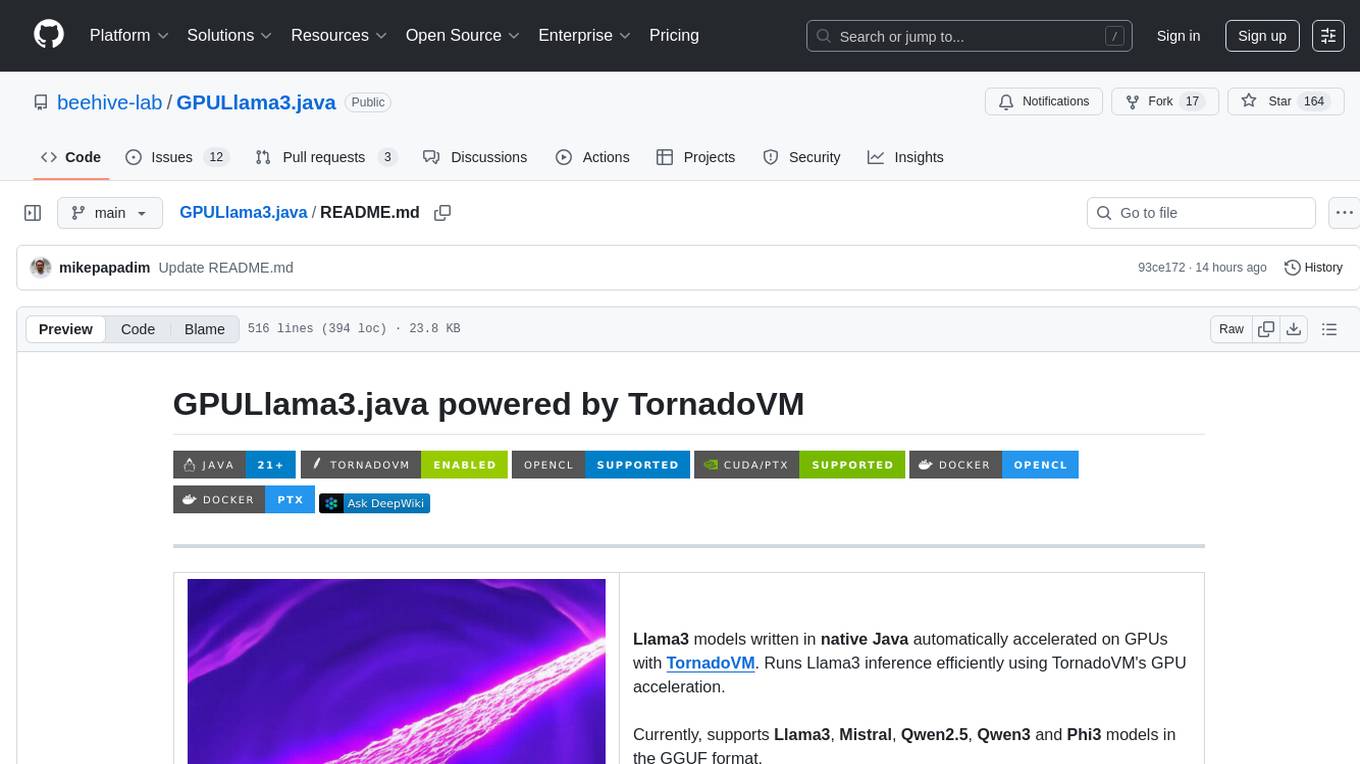
GPULlama3.java
GPULlama3.java powered by TornadoVM is a Java-native implementation of Llama3 that automatically compiles and executes Java code on GPUs via TornadoVM. It supports Llama3, Mistral, Qwen2.5, Qwen3, and Phi3 models in the GGUF format. The repository aims to provide GPU acceleration for Java code, enabling faster execution and high-performance access to off-heap memory. It offers features like interactive and instruction modes, flexible backend switching between OpenCL and PTX, and cross-platform compatibility with NVIDIA, Intel, and Apple GPUs.
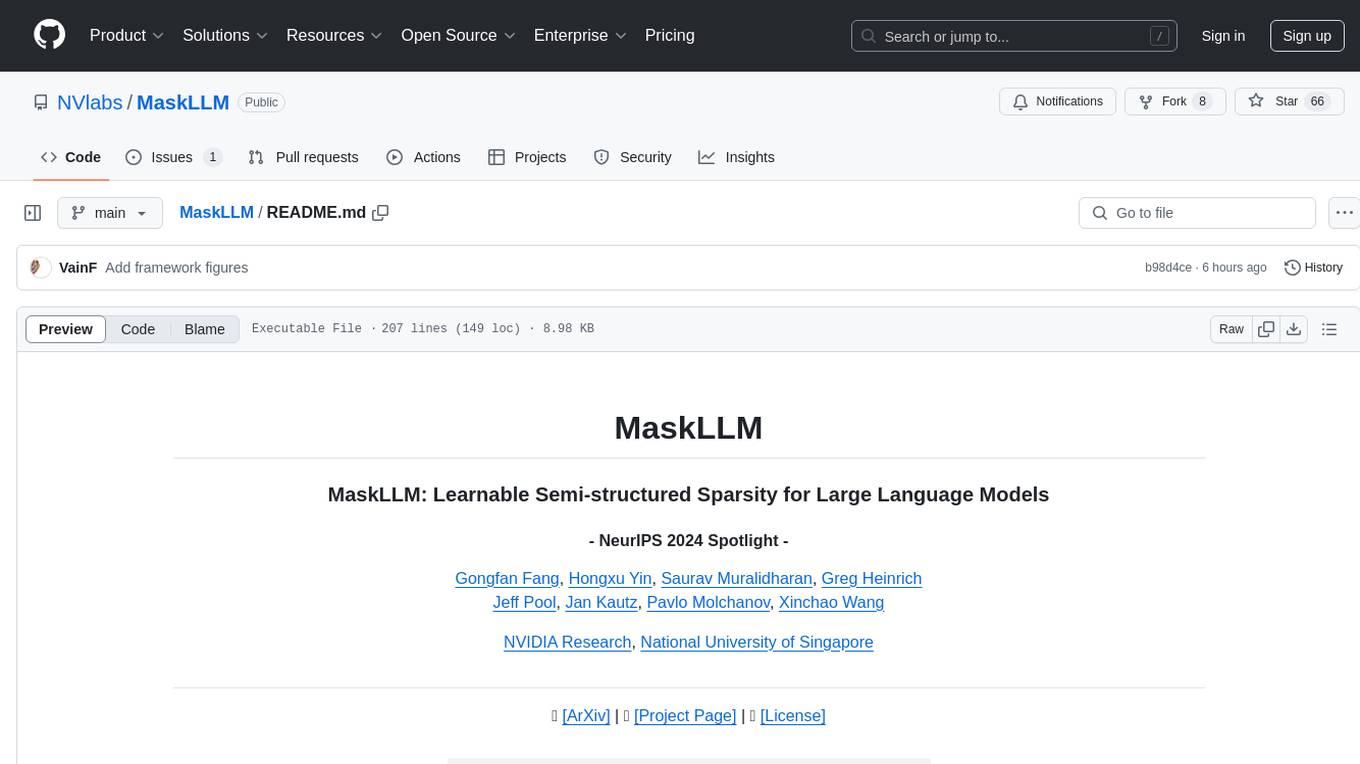
MaskLLM
MaskLLM is a learnable pruning method that establishes Semi-structured Sparsity in Large Language Models (LLMs) to reduce computational overhead during inference. It is scalable and benefits from larger training datasets. The tool provides examples for running MaskLLM with Megatron-LM, preparing LLaMA checkpoints, pre-tokenizing C4 data for Megatron, generating prior masks, training MaskLLM, and evaluating the model. It also includes instructions for exporting sparse models to Huggingface.
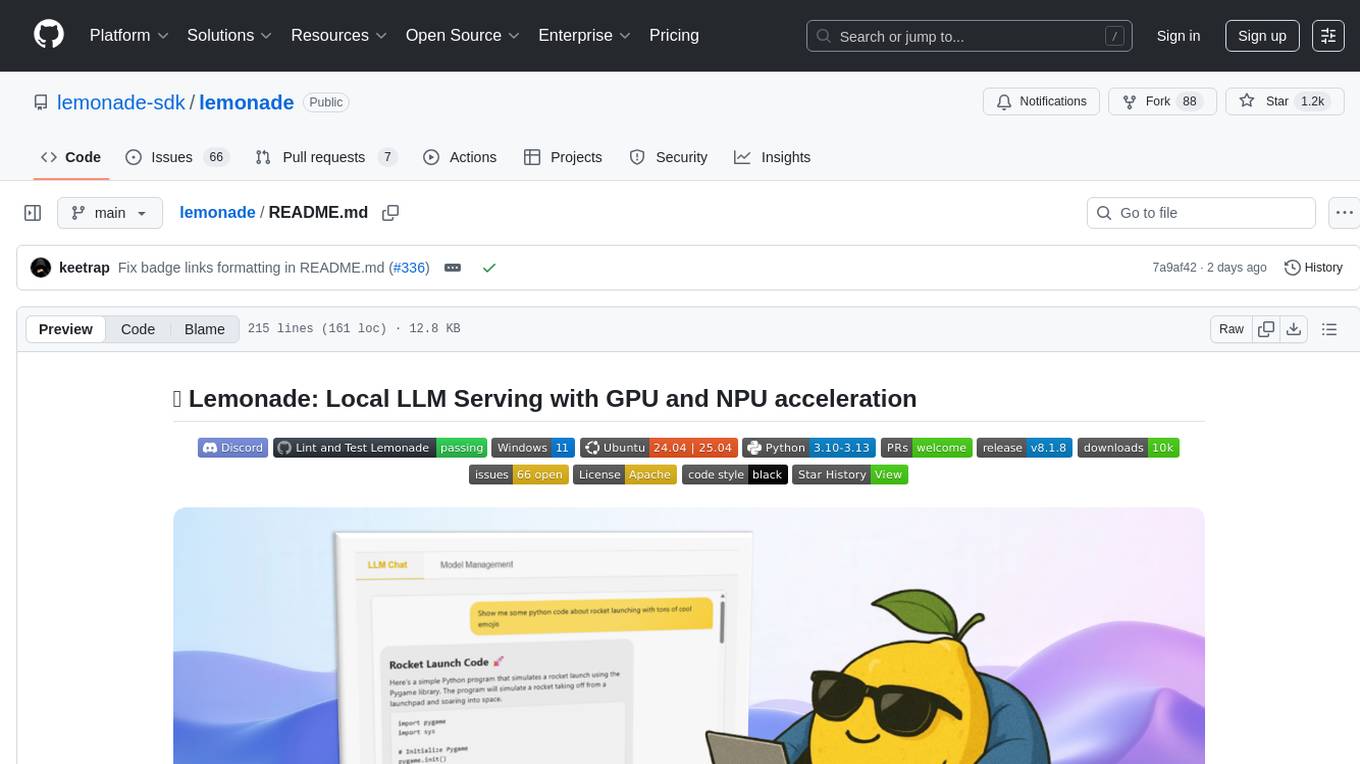
lemonade
Lemonade is a tool that helps users run local Large Language Models (LLMs) with high performance by configuring state-of-the-art inference engines for their Neural Processing Units (NPUs) and Graphics Processing Units (GPUs). It is used by startups, research teams, and large companies to run LLMs efficiently. Lemonade provides a high-level Python API for direct integration of LLMs into Python applications and a CLI for mixing and matching LLMs with various features like prompting templates, accuracy testing, performance benchmarking, and memory profiling. The tool supports both GGUF and ONNX models and allows importing custom models from Hugging Face using the Model Manager. Lemonade is designed to be easy to use and switch between different configurations at runtime, making it a versatile tool for running LLMs locally.
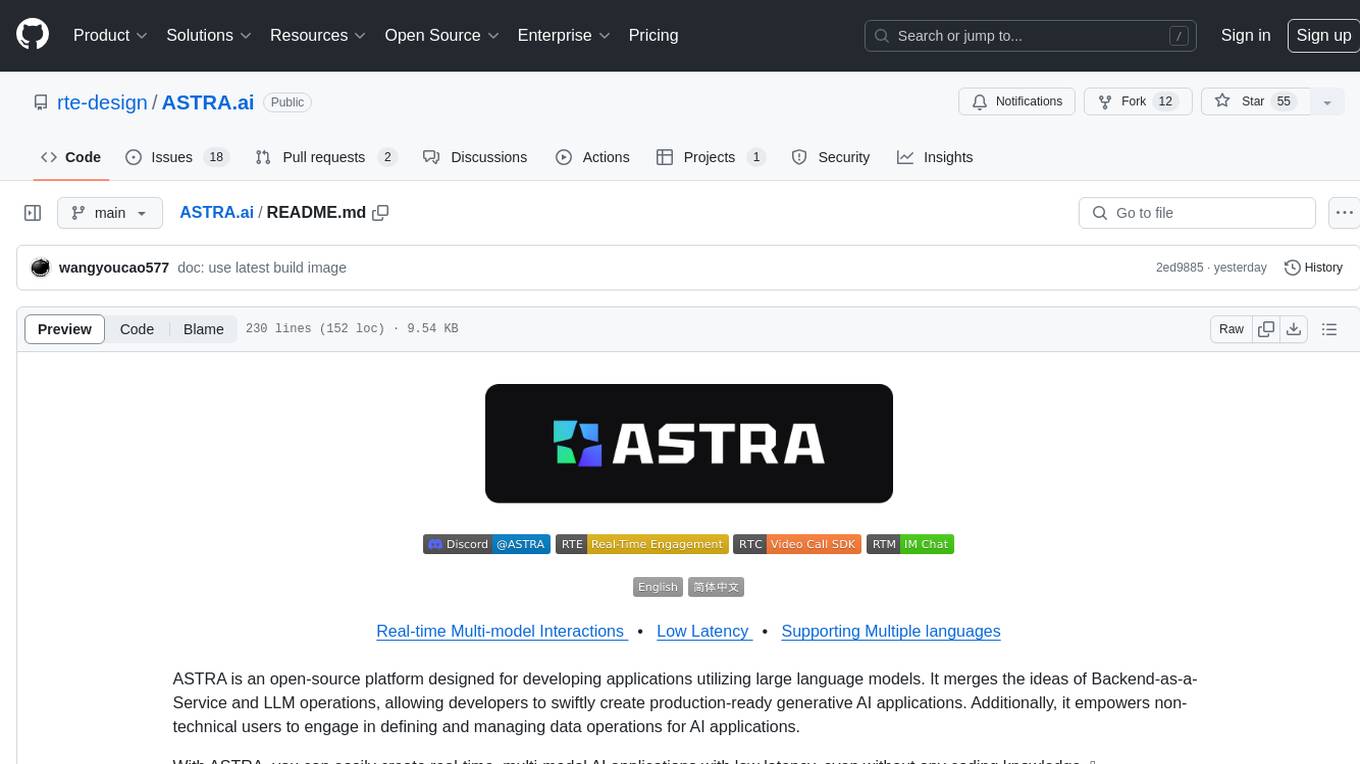
ASTRA.ai
ASTRA is an open-source platform designed for developing applications utilizing large language models. It merges the ideas of Backend-as-a-Service and LLM operations, allowing developers to swiftly create production-ready generative AI applications. Additionally, it empowers non-technical users to engage in defining and managing data operations for AI applications. With ASTRA, you can easily create real-time, multi-modal AI applications with low latency, even without any coding knowledge.
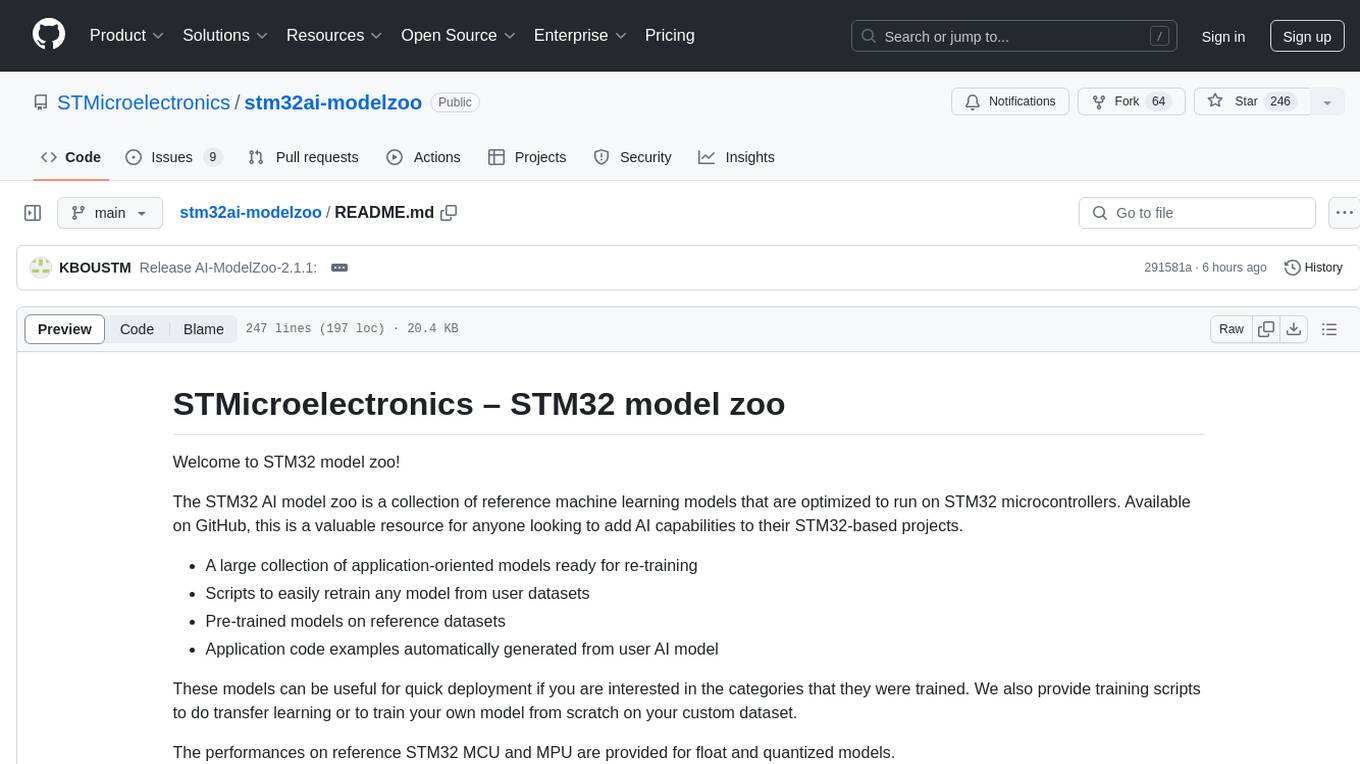
stm32ai-modelzoo
The STM32 AI model zoo is a collection of reference machine learning models optimized to run on STM32 microcontrollers. It provides a large collection of application-oriented models ready for re-training, scripts for easy retraining from user datasets, pre-trained models on reference datasets, and application code examples generated from user AI models. The project offers training scripts for transfer learning or training custom models from scratch. It includes performances on reference STM32 MCU and MPU for float and quantized models. The project is organized by application, providing step-by-step guides for training and deploying models.
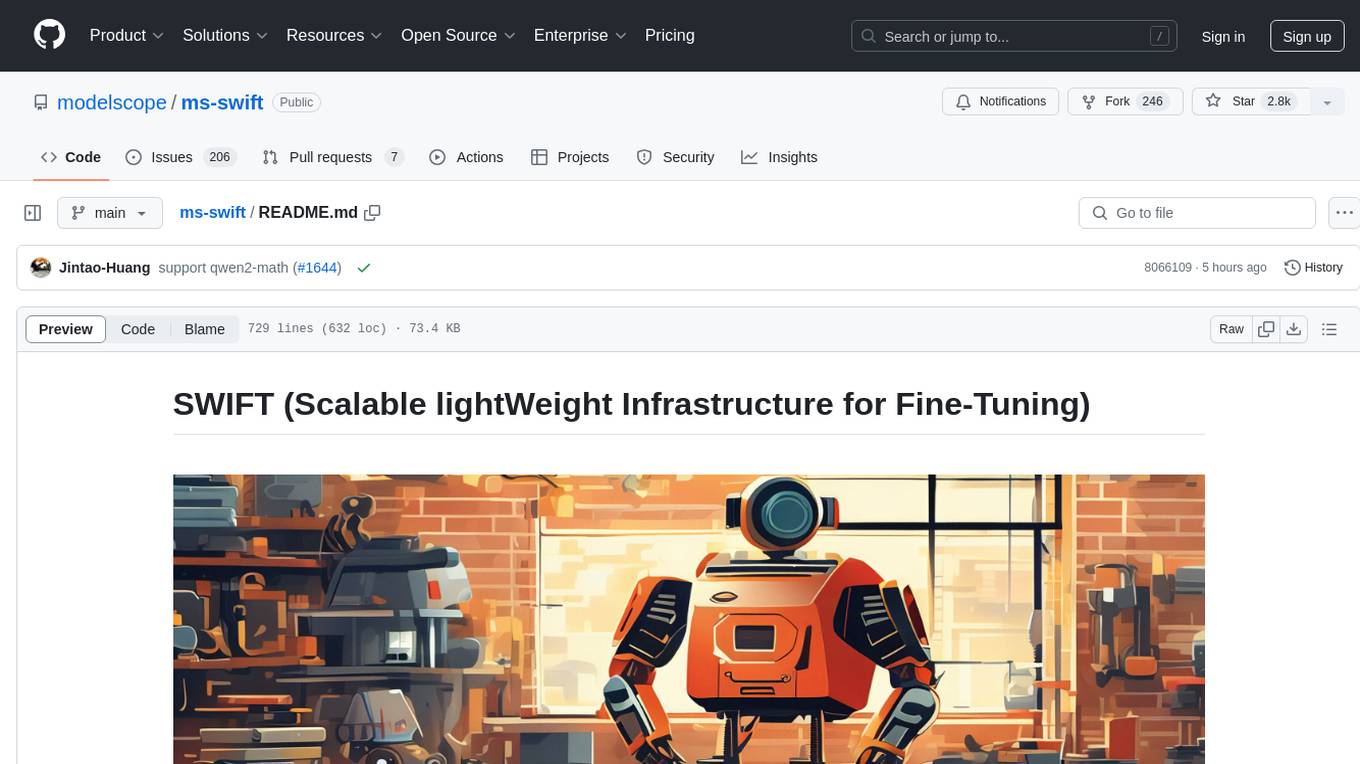
ms-swift
ms-swift is an official framework provided by the ModelScope community for fine-tuning and deploying large language models and multi-modal large models. It supports training, inference, evaluation, quantization, and deployment of over 400 large models and 100+ multi-modal large models. The framework includes various training technologies and accelerates inference, evaluation, and deployment modules. It offers a Gradio-based Web-UI interface and best practices for easy application of large models. ms-swift supports a wide range of model types, dataset types, hardware support, lightweight training methods, distributed training techniques, quantization training, RLHF training, multi-modal training, interface training, plugin and extension support, inference acceleration engines, model evaluation, and model quantization.

retinify
Retinify is an advanced AI-powered stereo vision library designed for robotics, enabling real-time, high-precision 3D perception by leveraging GPU and NPU acceleration. It is open source under Apache-2.0 license, offers high precision 3D mapping and object recognition, runs computations on GPU for fast performance, accepts stereo images from any rectified camera setup, is cost-efficient using minimal hardware, and has minimal dependencies on CUDA Toolkit, cuDNN, and TensorRT. The tool provides a pipeline for stereo matching and supports various image data types independently of OpenCV.
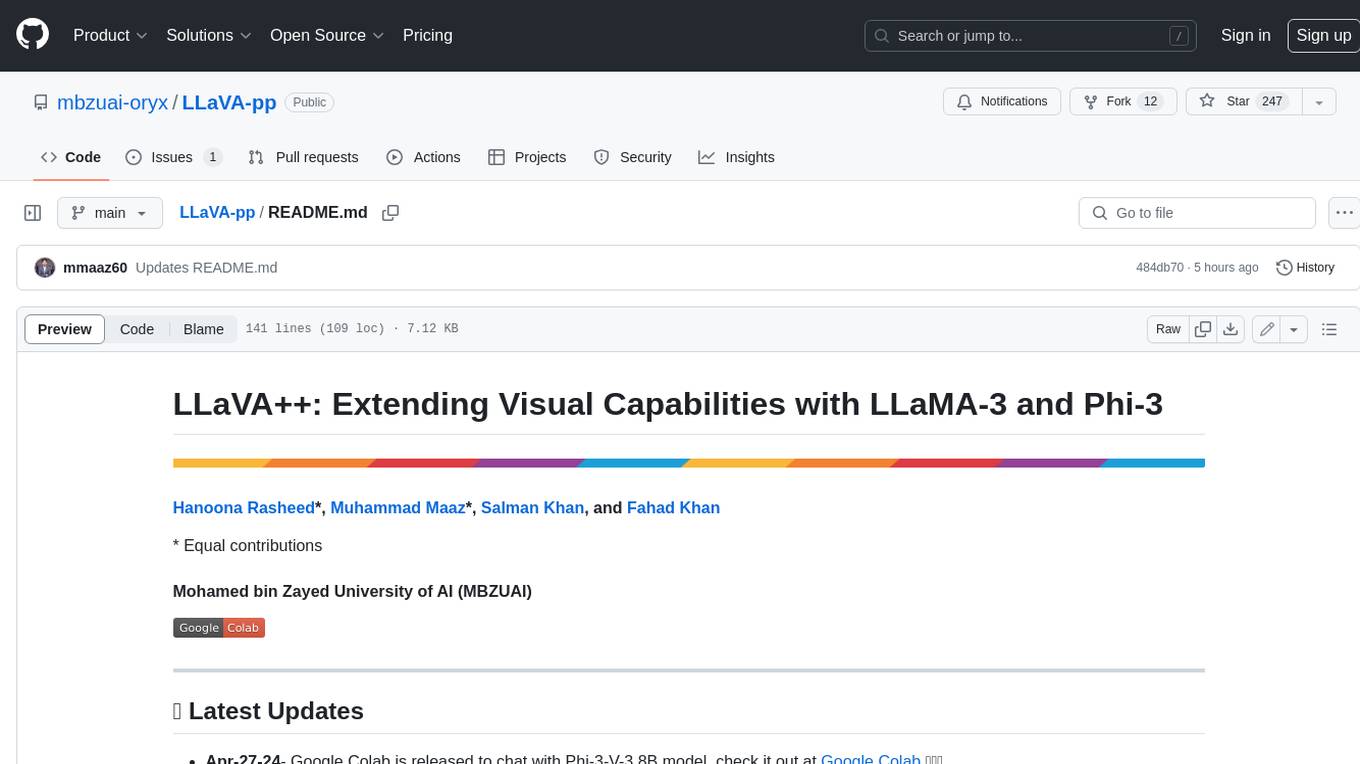
LLaVA-pp
This repository, LLaVA++, extends the visual capabilities of the LLaVA 1.5 model by incorporating the latest LLMs, Phi-3 Mini Instruct 3.8B, and LLaMA-3 Instruct 8B. It provides various models for instruction-following LMMS and academic-task-oriented datasets, along with training scripts for Phi-3-V and LLaMA-3-V. The repository also includes installation instructions and acknowledgments to related open-source contributions.
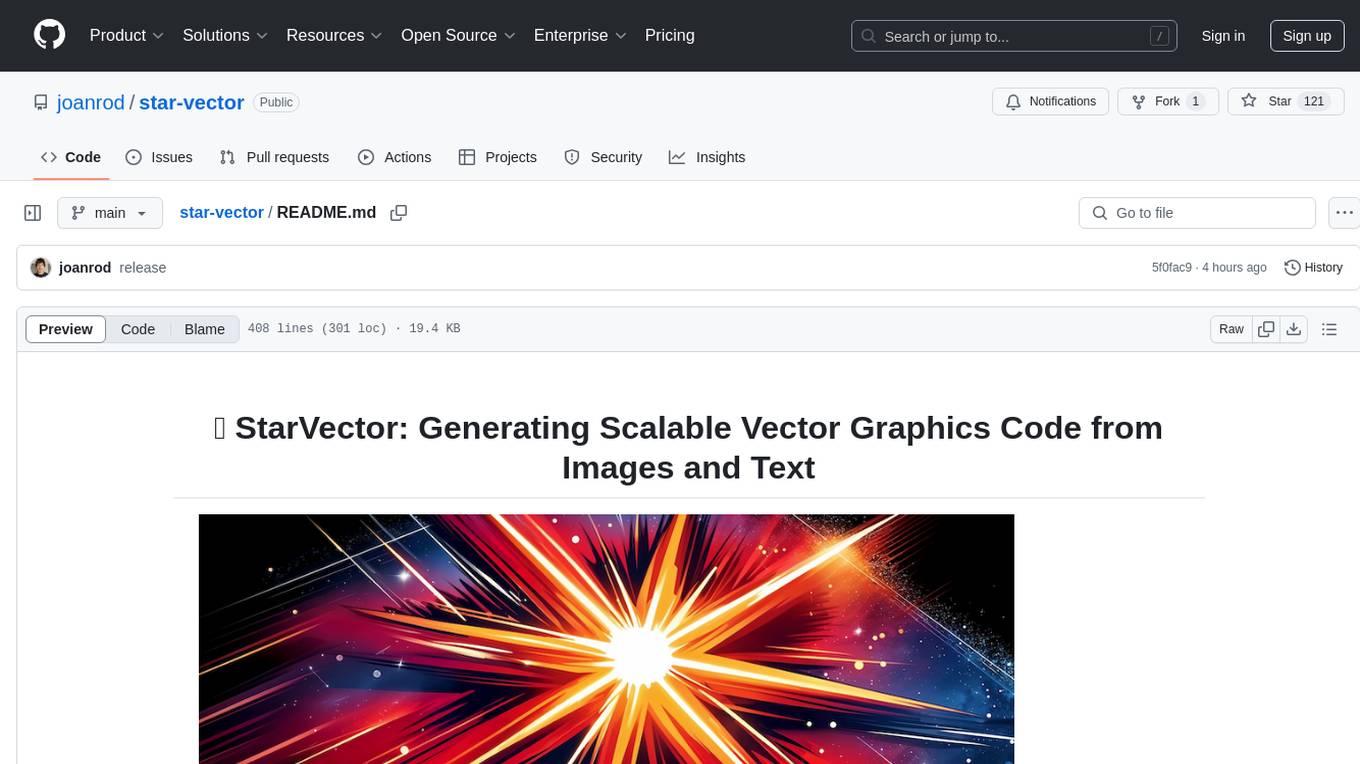
star-vector
StarVector is a multimodal vision-language model for Scalable Vector Graphics (SVG) generation. It can be used to perform image2SVG and text2SVG generation. StarVector works directly in the SVG code space, leveraging visual understanding to apply accurate SVG primitives. It achieves state-of-the-art performance in producing compact and semantically rich SVGs. The tool provides Hugging Face model checkpoints for image2SVG vectorization, with models like StarVector-8B and StarVector-1B. It also offers datasets like SVG-Stack, SVG-Fonts, SVG-Icons, SVG-Emoji, and SVG-Diagrams for evaluation. StarVector can be trained using Deepspeed or FSDP for tasks like Image2SVG and Text2SVG generation. The tool provides a demo with options for HuggingFace generation or VLLM backend for faster generation speed.

TTS-WebUI
TTS WebUI is a comprehensive tool for text-to-speech synthesis, audio/music generation, and audio conversion. It offers a user-friendly interface for various AI projects related to voice and audio processing. The tool provides a range of models and extensions for different tasks, along with integrations like Silly Tavern and OpenWebUI. With support for Docker setup and compatibility with Linux and Windows, TTS WebUI aims to facilitate creative and responsible use of AI technologies in a user-friendly manner.
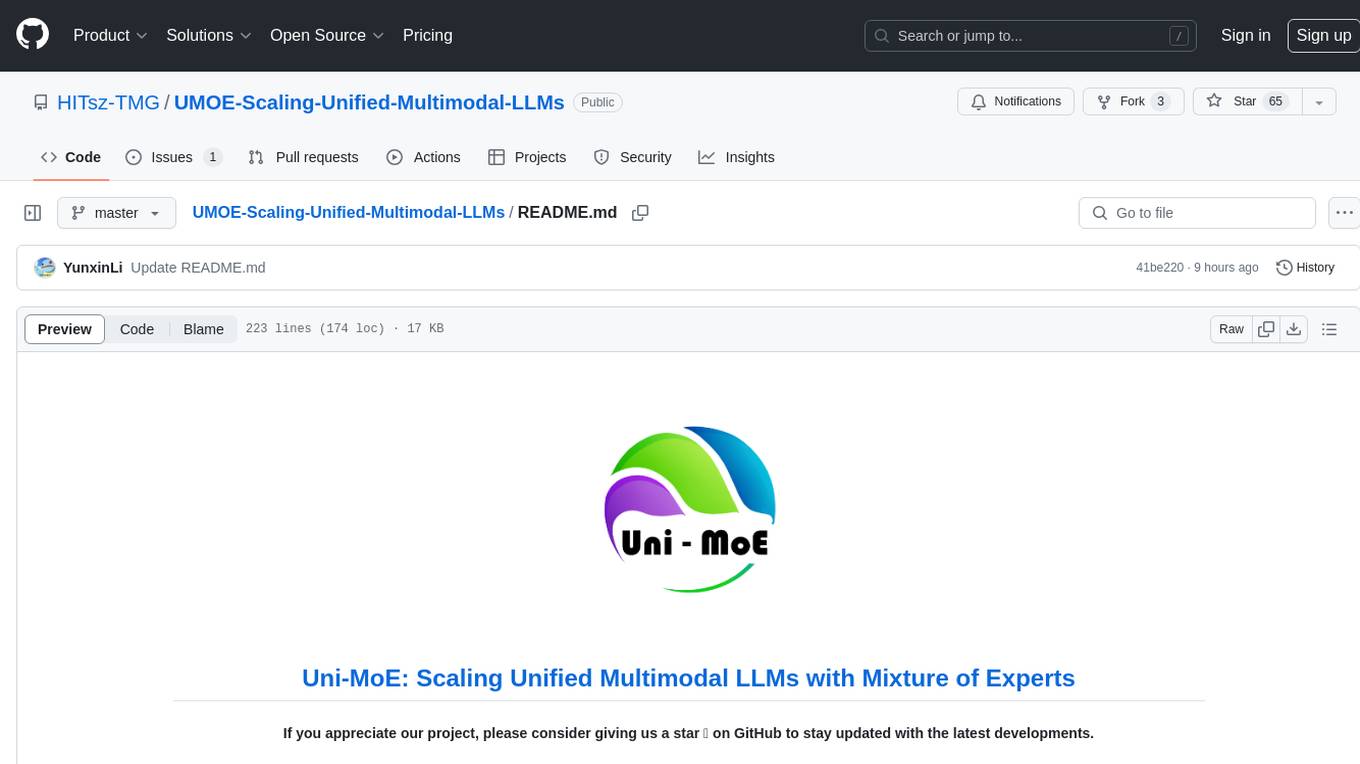
UMOE-Scaling-Unified-Multimodal-LLMs
Uni-MoE is a MoE-based unified multimodal model that can handle diverse modalities including audio, speech, image, text, and video. The project focuses on scaling Unified Multimodal LLMs with a Mixture of Experts framework. It offers enhanced functionality for training across multiple nodes and GPUs, as well as parallel processing at both the expert and modality levels. The model architecture involves three training stages: building connectors for multimodal understanding, developing modality-specific experts, and incorporating multiple trained experts into LLMs using the LoRA technique on mixed multimodal data. The tool provides instructions for installation, weights organization, inference, training, and evaluation on various datasets.
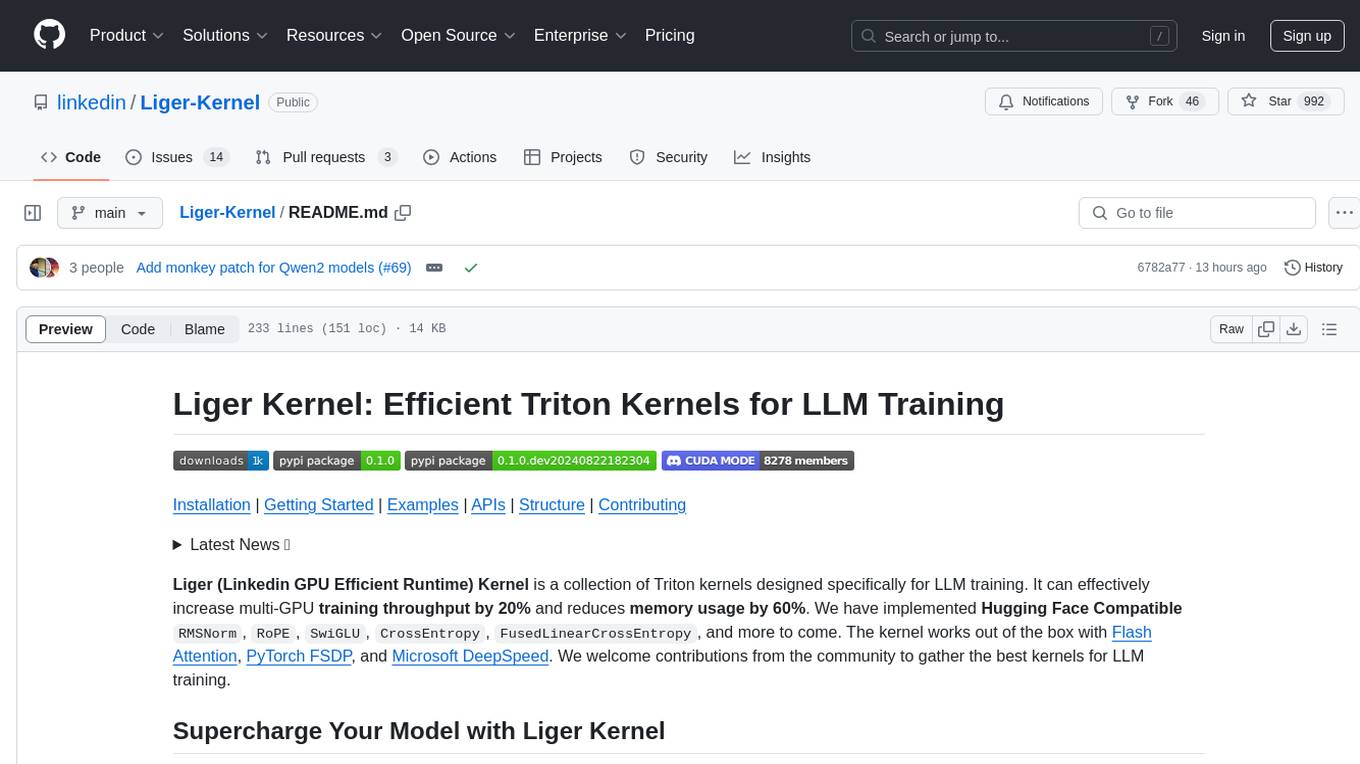
Liger-Kernel
Liger Kernel is a collection of Triton kernels designed for LLM training, increasing training throughput by 20% and reducing memory usage by 60%. It includes Hugging Face Compatible modules like RMSNorm, RoPE, SwiGLU, CrossEntropy, and FusedLinearCrossEntropy. The tool works with Flash Attention, PyTorch FSDP, and Microsoft DeepSpeed, aiming to enhance model efficiency and performance for researchers, ML practitioners, and curious novices.

intel-extension-for-tensorflow
Intel® Extension for TensorFlow* is a high performance deep learning extension plugin based on TensorFlow PluggableDevice interface. It aims to accelerate AI workloads by allowing users to plug Intel CPU or GPU devices into TensorFlow on-demand, exposing the computing power inside Intel's hardware. The extension provides XPU specific implementation, kernels & operators, graph optimizer, device runtime, XPU configuration management, XPU backend selection, and options for turning on/off advanced features.
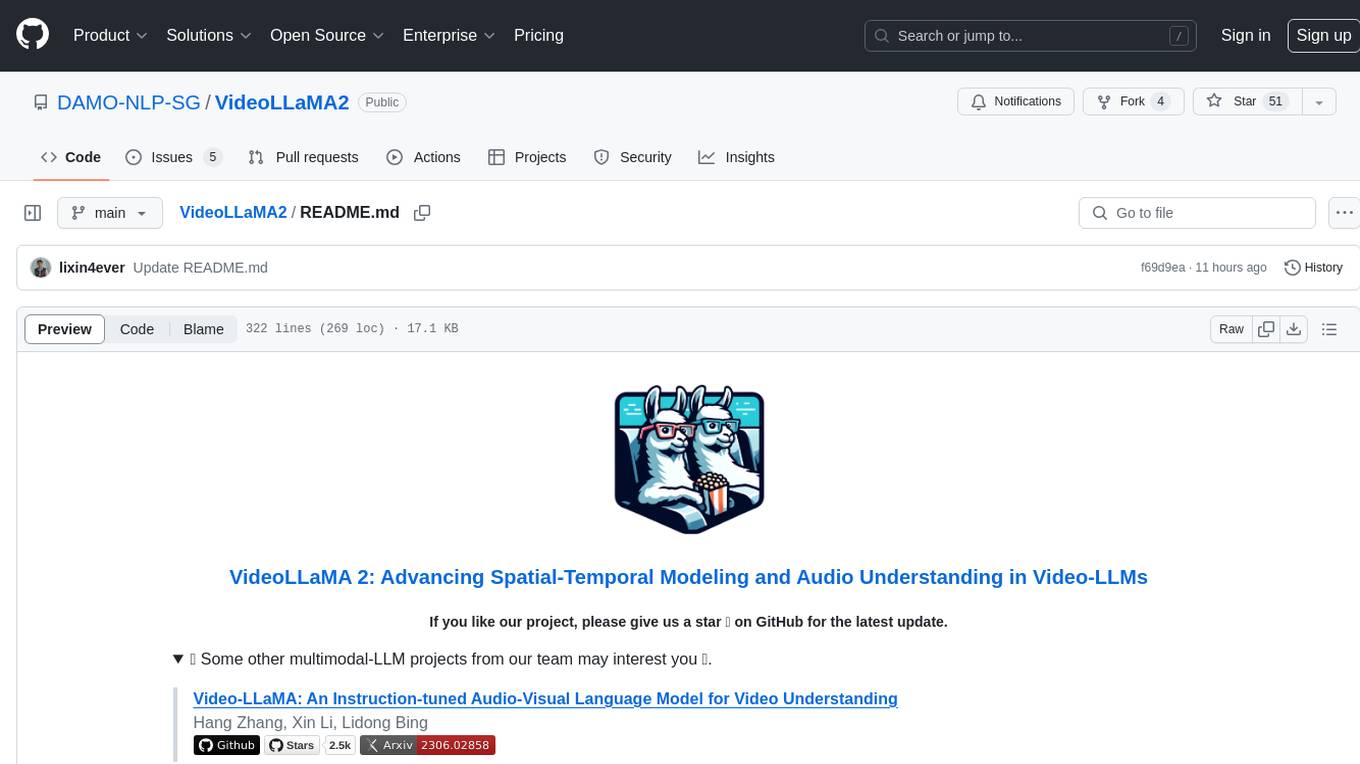
VideoLLaMA2
VideoLLaMA 2 is a project focused on advancing spatial-temporal modeling and audio understanding in video-LLMs. It provides tools for multi-choice video QA, open-ended video QA, and video captioning. The project offers model zoo with different configurations for visual encoder and language decoder. It includes training and evaluation guides, as well as inference capabilities for video and image processing. The project also features a demo setup for running a video-based Large Language Model web demonstration.
For similar tasks

rwkv-qualcomm
This repository provides support for inference RWKV models on Qualcomm HTP (Hexagon Tensor Processor) using QNN SDK. It supports RWKV v5, v6, and experimentally v7 models, inference using Qualcomm CPU, GPU, or HTP as the backend, whole-model float16 inference, activation INT16 and weights INT8 quantized inference, and activation INT16 and weights INT4/INT8 mixed quantized inference. Users can convert model weights to QNN model library files, generate HTP context cache, and run inference on Qualcomm Snapdragon SM8650 with HTP v75. The project requires QNN SDK, AIMET toolkit, and specific hardware for verification.
For similar jobs
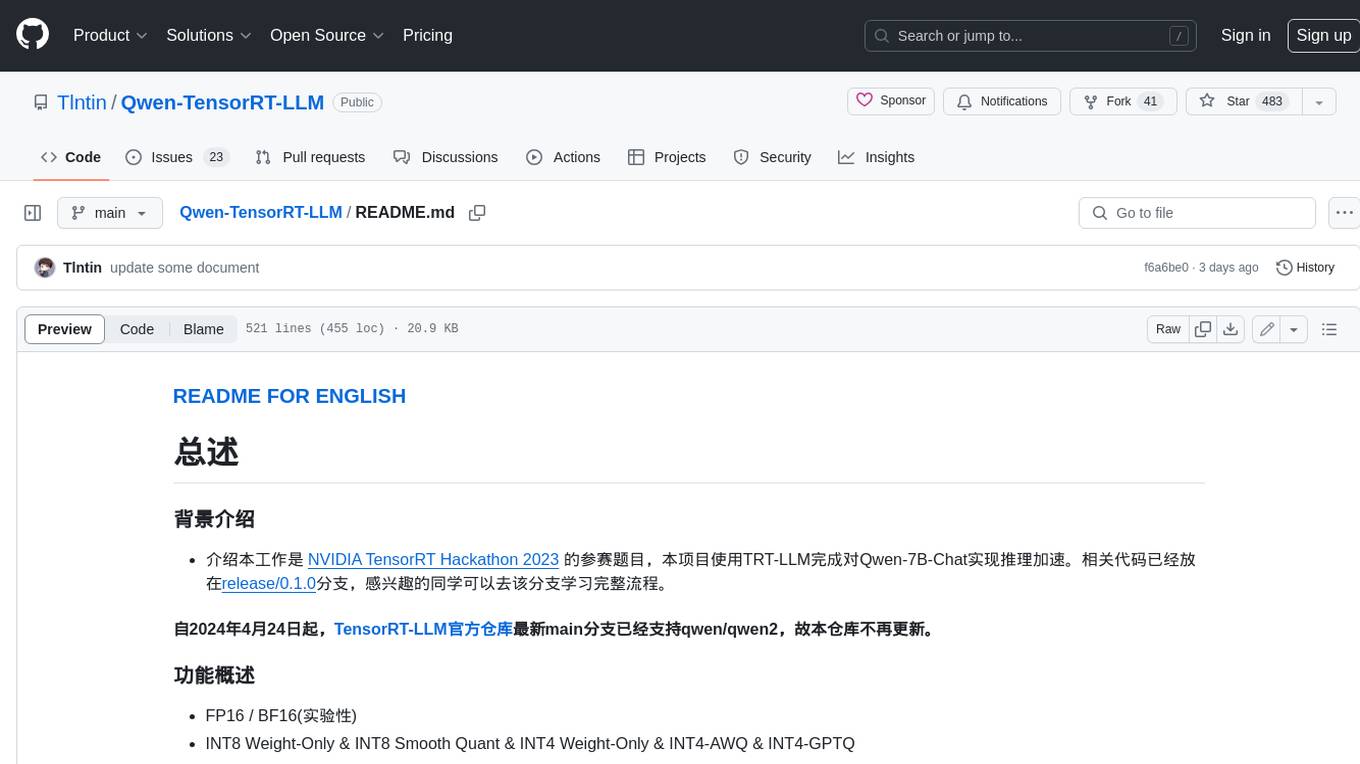
Qwen-TensorRT-LLM
Qwen-TensorRT-LLM is a project developed for the NVIDIA TensorRT Hackathon 2023, focusing on accelerating inference for the Qwen-7B-Chat model using TRT-LLM. The project offers various functionalities such as FP16/BF16 support, INT8 and INT4 quantization options, Tensor Parallel for multi-GPU parallelism, web demo setup with gradio, Triton API deployment for maximum throughput/concurrency, fastapi integration for openai requests, CLI interaction, and langchain support. It supports models like qwen2, qwen, and qwen-vl for both base and chat models. The project also provides tutorials on Bilibili and blogs for adapting Qwen models in NVIDIA TensorRT-LLM, along with hardware requirements and quick start guides for different model types and quantization methods.
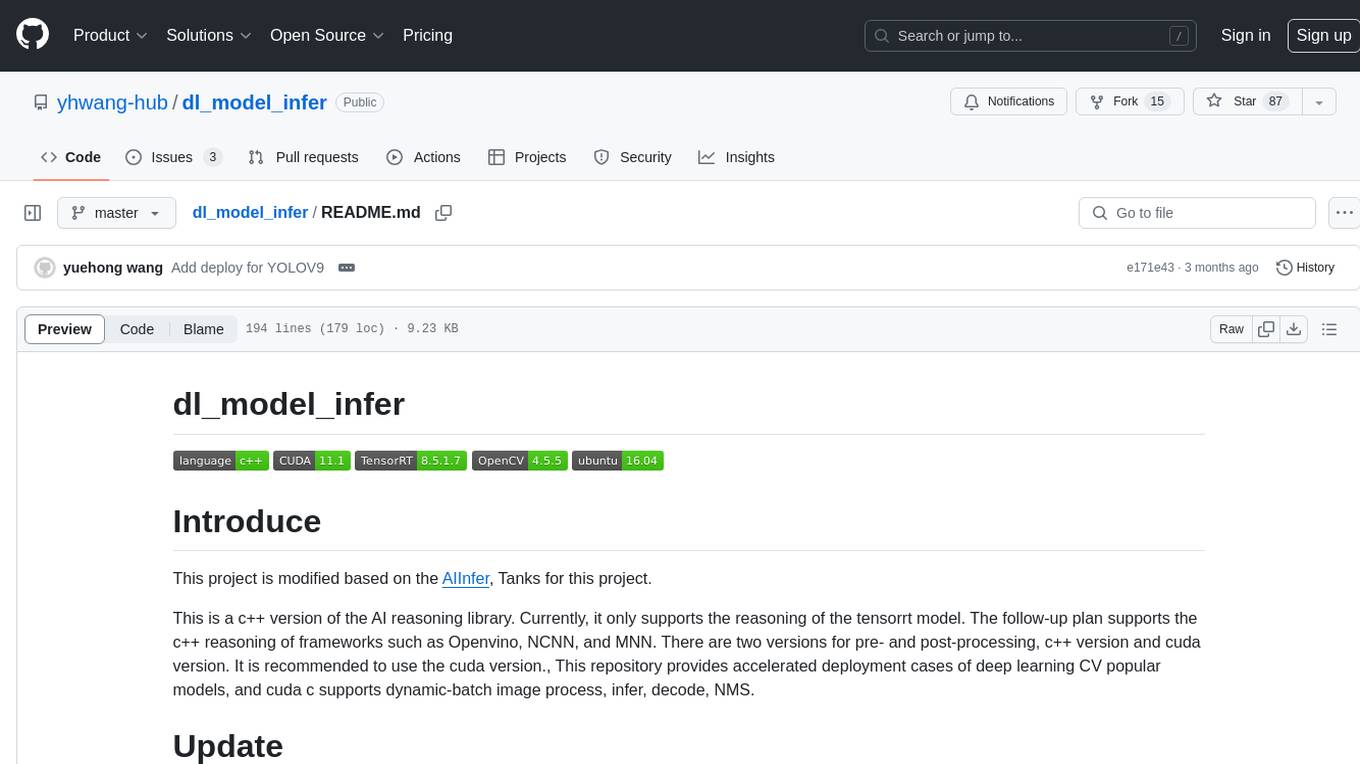
dl_model_infer
This project is a c++ version of the AI reasoning library that supports the reasoning of tensorrt models. It provides accelerated deployment cases of deep learning CV popular models and supports dynamic-batch image processing, inference, decode, and NMS. The project has been updated with various models and provides tutorials for model exports. It also includes a producer-consumer inference model for specific tasks. The project directory includes implementations for model inference applications, backend reasoning classes, post-processing, pre-processing, and target detection and tracking. Speed tests have been conducted on various models, and onnx downloads are available for different models.

joliGEN
JoliGEN is an integrated framework for training custom generative AI image-to-image models. It implements GAN, Diffusion, and Consistency models for various image translation tasks, including domain and style adaptation with conservation of semantics. The tool is designed for real-world applications such as Controlled Image Generation, Augmented Reality, Dataset Smart Augmentation, and Synthetic to Real transforms. JoliGEN allows for fast and stable training with a REST API server for simplified deployment. It offers a wide range of options and parameters with detailed documentation available for models, dataset formats, and data augmentation.

ai-edge-torch
AI Edge Torch is a Python library that supports converting PyTorch models into a .tflite format for on-device applications on Android, iOS, and IoT devices. It offers broad CPU coverage with initial GPU and NPU support, closely integrating with PyTorch and providing good coverage of Core ATen operators. The library includes a PyTorch converter for model conversion and a Generative API for authoring mobile-optimized PyTorch Transformer models, enabling easy deployment of Large Language Models (LLMs) on mobile devices.
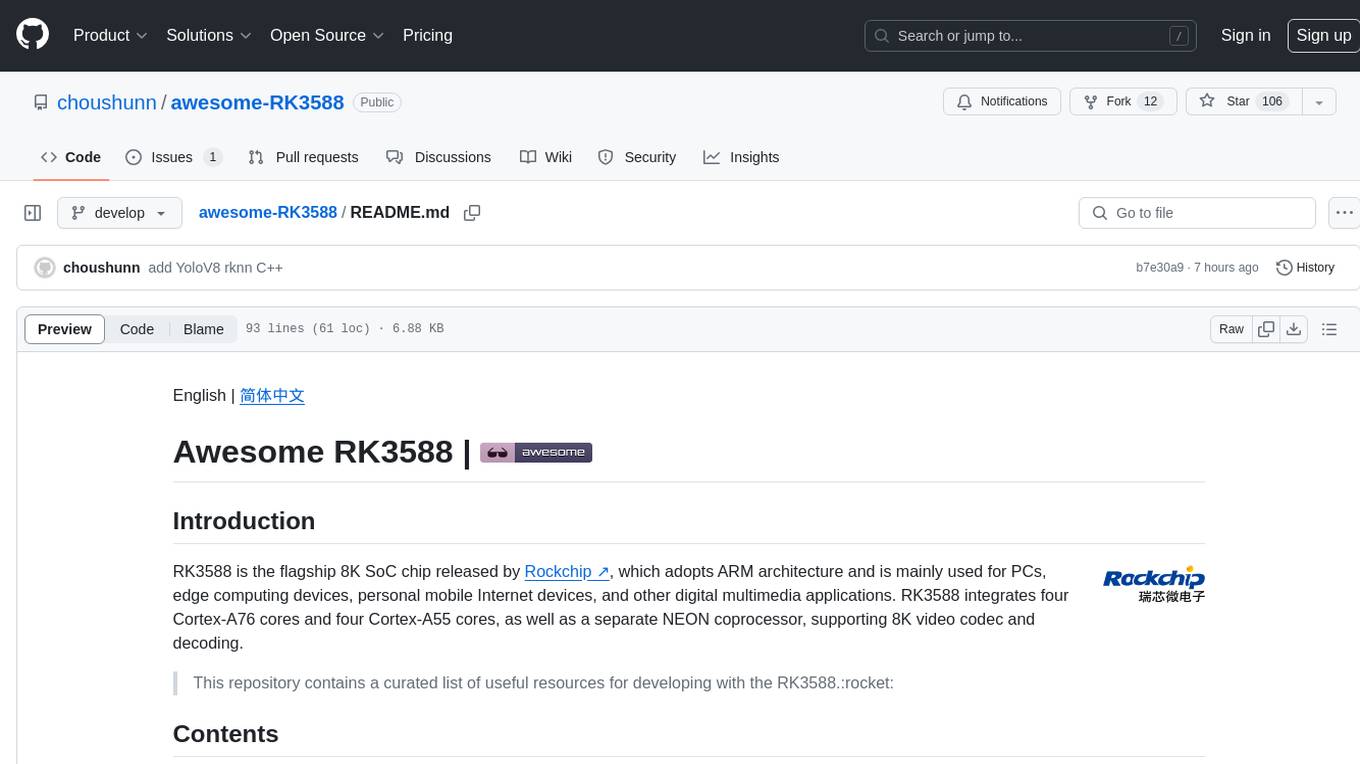
awesome-RK3588
RK3588 is a flagship 8K SoC chip by Rockchip, integrating Cortex-A76 and Cortex-A55 cores with NEON coprocessor for 8K video codec. This repository curates resources for developing with RK3588, including official resources, RKNN models, projects, development boards, documentation, tools, and sample code.
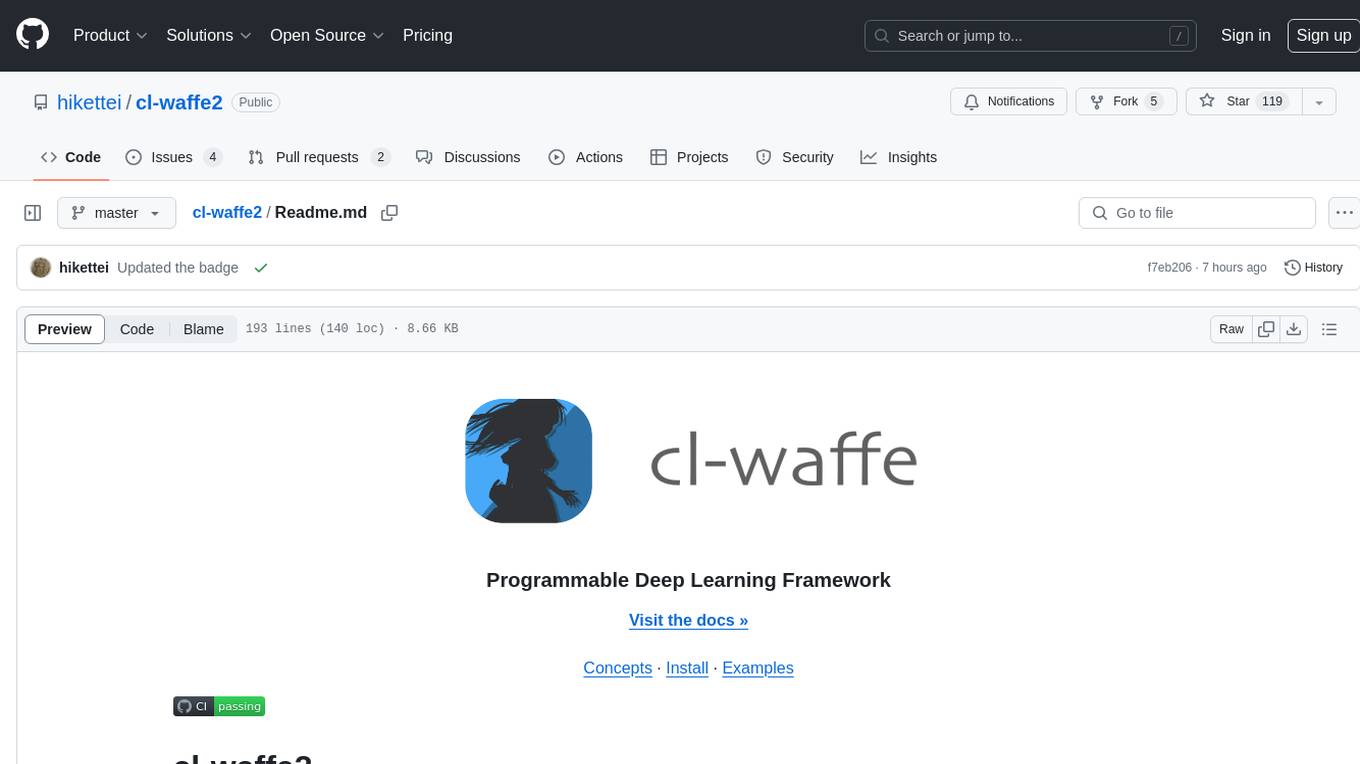
cl-waffe2
cl-waffe2 is an experimental deep learning framework in Common Lisp, providing fast, systematic, and customizable matrix operations, reverse mode tape-based Automatic Differentiation, and neural network model building and training features accelerated by a JIT Compiler. It offers abstraction layers, extensibility, inlining, graph-level optimization, visualization, debugging, systematic nodes, and symbolic differentiation. Users can easily write extensions and optimize their networks without overheads. The framework is designed to eliminate barriers between users and developers, allowing for easy customization and extension.
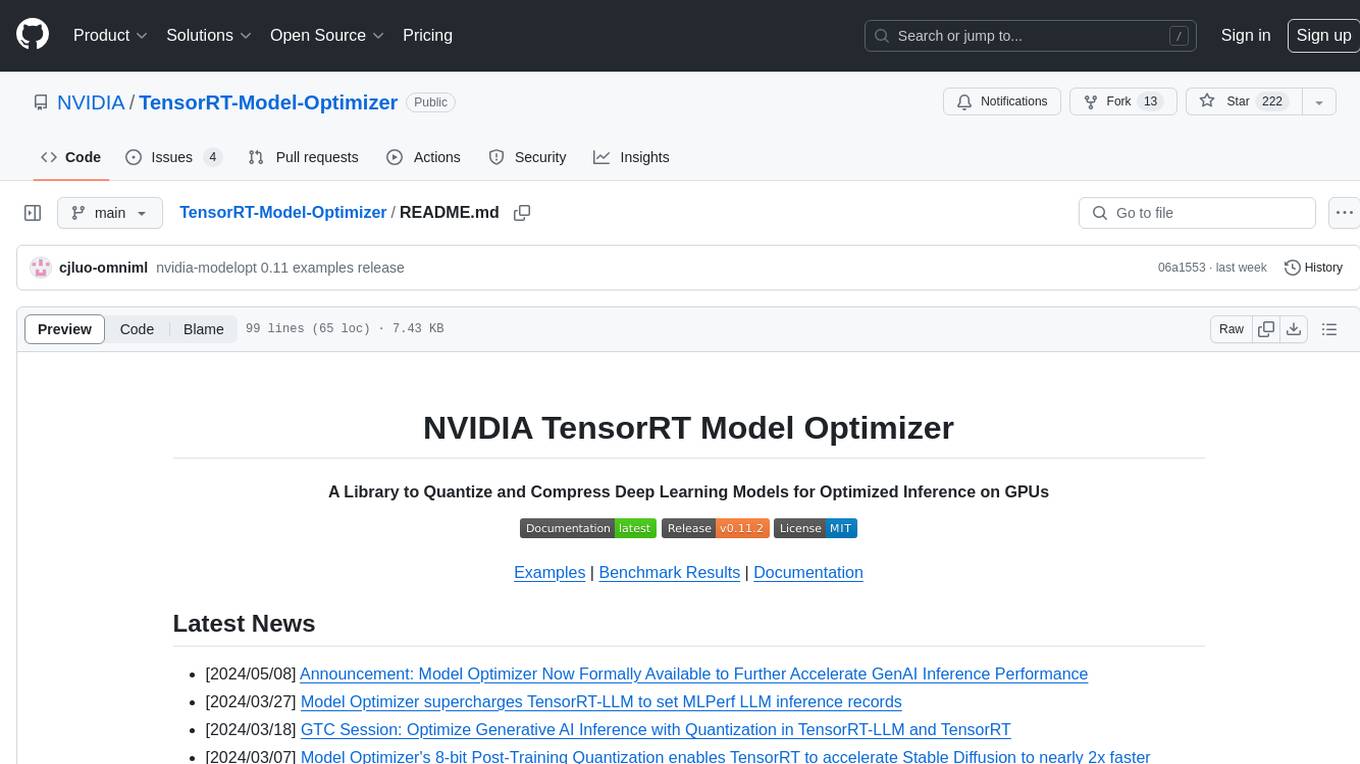
TensorRT-Model-Optimizer
The NVIDIA TensorRT Model Optimizer is a library designed to quantize and compress deep learning models for optimized inference on GPUs. It offers state-of-the-art model optimization techniques including quantization and sparsity to reduce inference costs for generative AI models. Users can easily stack different optimization techniques to produce quantized checkpoints from torch or ONNX models. The quantized checkpoints are ready for deployment in inference frameworks like TensorRT-LLM or TensorRT, with planned integrations for NVIDIA NeMo and Megatron-LM. The tool also supports 8-bit quantization with Stable Diffusion for enterprise users on NVIDIA NIM. Model Optimizer is available for free on NVIDIA PyPI, and this repository serves as a platform for sharing examples, GPU-optimized recipes, and collecting community feedback.
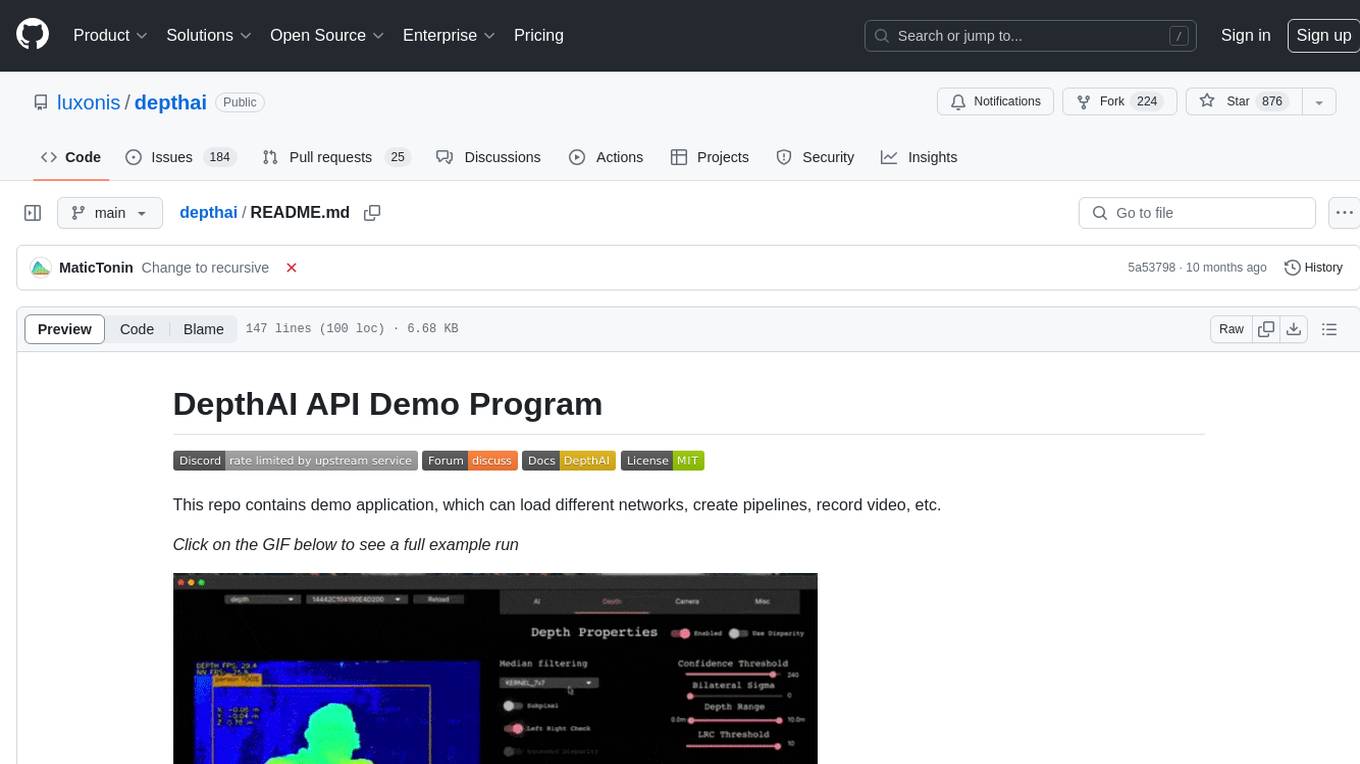
depthai
This repository contains a demo application for DepthAI, a tool that can load different networks, create pipelines, record video, and more. It provides documentation for installation and usage, including running programs through Docker. Users can explore DepthAI features via command line arguments or a clickable QT interface. Supported models include various AI models for tasks like face detection, human pose estimation, and object detection. The tool collects anonymous usage statistics by default, which can be disabled. Users can report issues to the development team for support and troubleshooting.
